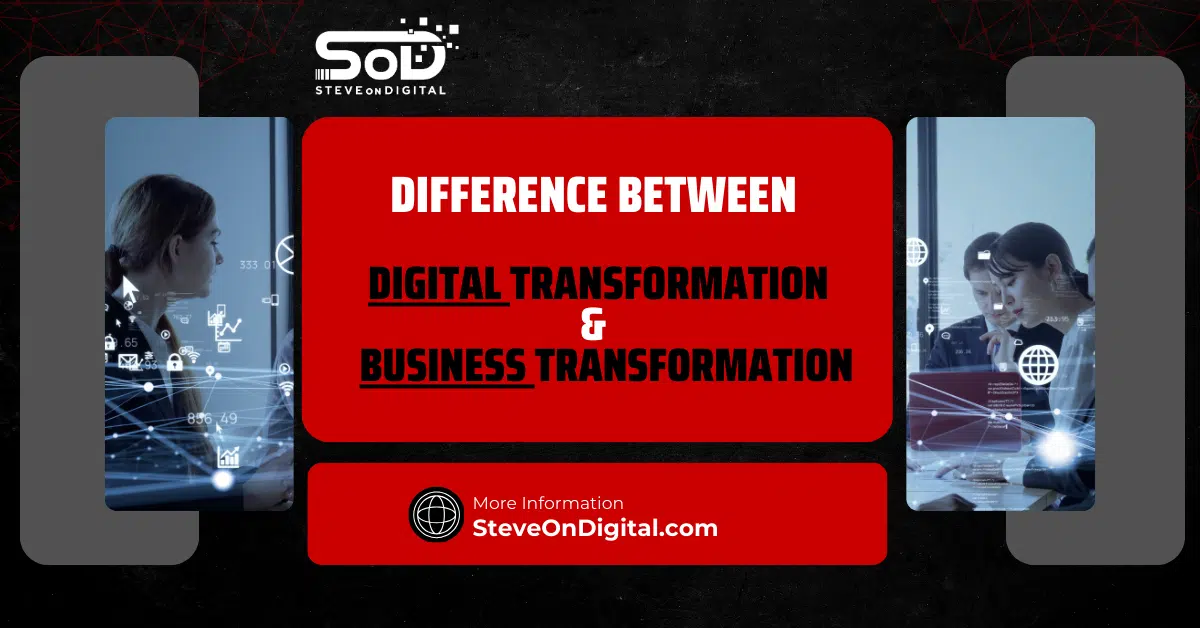Many business owners hesitate to start digital transformation because they believe common myths. These misconceptions can make the process seem more complex and overwhelming than it is in the digital age.
Digital transformation is not just one project, nor does it require changing everything at once. It’s an ongoing journey that integrates new digital technologies into existing business processes. The strategic integration of digital technology is crucial for fundamentally enhancing operations and customer experiences. Understanding and debunking these myths can help you embrace digital transformation successfully, ensuring that your business stays competitive and meets evolving customer expectations.
I’m Steve, a digital transformation expert with a strong background in electrical engineering, an MBA, and a master’s in Project Management. I excel at helping SMEs navigate the digital landscape with practical insights. Let’s begin!
Common Myths of Digital Transformation
Many business owners hesitate to embark on their digital transformation journey due to common misconceptions. These myths can create unnecessary fears and misaligned expectations, making the process seem more daunting than it really is. In this section, I’ll debunk these myths to provide a clearer understanding of what digital transformation truly entails.
Myth 1: Digital Transformation Is Just One Project
One of the most pervasive myths about digital transformation is that it’s a single, massive project with a clear beginning and end. The truth is far from this simplistic view.
Understanding the Digital Transformation Journey
Digital transformation is not a one-time event; it’s an ongoing journey that involves multiple projects, phases, and adaptations over time. It’s about continuously evolving to meet new challenges and customer expectations. From my experience, I’ve seen businesses struggle when they treat digital transformation initiatives as a one-off project. Instead, think of it as a series of steps that require constant reassessment and adjustment.
The Role of a Digital Roadmap
To manage this ongoing journey, a digital roadmap is crucial. This roadmap breaks down the transformation into manageable steps, allowing for pauses and reassessments along the way. These pauses aren’t just idle times—they’re opportunities to evaluate progress, gather feedback, and make necessary adjustments. A well-thought-out roadmap ensures that the transformation aligns with your overall business objectives, keeping everyone on the same page.
Myth 2: Digital Transformation Requires Everything to Change
Another common misconception is that digital transformation means completely overhauling all existing processes. This myth often leads to unnecessary resistance within organizations, particularly among employees who are wary of change.
Balancing Change and Continuity
The reality is that digital transformation doesn’t require you to throw out everything that’s already working. Instead, it’s about integrating new technologies with existing processes and reimagining business models to enhance efficiency and meet evolving customer expectations. In my consulting work, I’ve found that the most successful transformations strike a balance between preserving effective practices and introducing new digital tools.
Managing Resistance to Change
Change, even when positive, often meets with resistance. This resistance can stem from fear of the unknown or concerns about job security. To mitigate this, it’s important to involve employees early in the transformation process, communicate clearly, and provide adequate training. When employees feel included and supported, they’re more likely to embrace the changes and contribute to the transformation’s success.
Myth 3: Digital Transformation Takes Forever
Many business owners believe that digital transformation is an endless process that drags on indefinitely, draining resources without delivering tangible results. This myth can be particularly discouraging, leading to hesitation in starting the transformation journey at all.
Achieving Quick Wins
While digital transformation is indeed an ongoing process, that doesn’t mean it has to take forever to see results. By identifying and focusing on quick wins—small, manageable projects that can be completed early on—you can build momentum and demonstrate the value of the transformation. These early successes not only boost employee morale but also help secure continued support from stakeholders.
Communicating Progress
Transparency is key to keeping everyone motivated throughout the transformation journey. Regularly communicating progress, celebrating milestones, and updating the digital roadmap as necessary helps maintain focus and ensure that the transformation doesn’t feel like an endless endeavor. In my experience, clear and consistent communication can make all the difference in keeping a transformation on track.
Myth 4: Digital Transformation Only Leads to Gadgets
There’s a misconception that digital transformation is all about adding the latest gadgets and gizmos to your business operations. This myth trivializes the strategic importance of digital transformation, reducing it to a mere tech upgrade.
Involving Employees in Tool Selection
Digital tools are indeed a critical component of transformation, but they’re far from being just “gadgets.” These tools are carefully selected to meet specific business needs, enhance efficiency, and improve customer experiences. Involving employees in the selection process ensures that the tools chosen are not only effective but also embraced by those who will use them daily.
Maximizing Tool Utilization
Once the right tools are selected, it’s crucial to maximize their utilization. This involves proper configuration, training, and ongoing support to ensure that employees can use the tools to their full potential. From my own experience, I’ve seen how effective training can turn initial skepticism into enthusiasm, leading to greater productivity and satisfaction.
Myth 5: Digital Transformation Is All About Technology
Another widespread myth is that digital transformation is solely about technology. This view overlooks the most important aspect of any business: its people.
People-Centric Transformation
While technology is a key enabler of digital transformation, the true driving force is the people who use that technology. The success of any transformation effort hinges on understanding and meeting the needs of employees and customers. I’ve always emphasized a people-first approach in my consulting work, and it’s consistently proven to be the most effective strategy.
Technology as an Enabler
Technology should be viewed as a tool that supports the transformation process, not as the end goal. It’s there to enhance operational efficiency, streamline business processes, and ultimately deliver better customer experiences. By keeping the focus on people and their needs, businesses can ensure that their digital transformation efforts lead to meaningful and lasting improvements.
Myth 6: Digital Transformation Is Only for Big Companies
Many small business owners believe that digital transformation is a luxury only large corporations can afford. This myth is particularly damaging because it can prevent small businesses from pursuing valuable opportunities.
Affordable Solutions for SMBs
The truth is that digital transformation is accessible to businesses of all sizes. There are numerous cost-effective tools and strategies available that can help small- and medium-sized businesses (SMBs) embark on their digital transformation journey without breaking the bank. Cloud-based solutions, for example, offer scalable and affordable options that can grow with your business.
Success Stories from Small Businesses
I’ve worked with numerous small businesses that have successfully implemented digital transformation strategies. These businesses didn’t have massive budgets or large IT departments, but they leveraged digital tools creatively to drive innovation and achieve their business objectives. By focusing on what matters most to their customers and aligning their digital transformation efforts with their business goals, they were able to achieve significant results.
Myth 7: Digital Transformation Is Very Expensive
Finally, there’s the belief that digital transformation is prohibitively expensive, especially for small businesses with limited resources. This myth can be a major barrier to starting the transformation process.
Cost-Effective Strategies
Digital transformation doesn’t have to be a costly endeavor. By adopting cost-effective strategies, such as using open-source software, cloud computing, and pay-as-you-go services, small businesses can manage costs while still achieving their transformation goals. It’s also important to prioritize investments in areas that will have the most significant impact, rather than trying to transform everything at once.
The ROI of Digital Transformation
One of the key benefits of digital transformation is the potential for long-term savings and increased profitability. By streamlining processes, improving operational efficiency, and enhancing customer experiences, digital transformation can deliver a strong return on investment (ROI). In my consulting experience, I’ve seen businesses significantly reduce costs and boost profits by embracing digital transformation, even with modest initial investments.
Key Components of a Successful Digital Transformation
Embarking on a digital transformation journey is like setting out on a new adventure. There are essential components you must have in place to ensure you’re not just moving forward but moving in the right direction. Over the years, I’ve seen how a well-planned strategy, leveraging emerging technologies, and actively engaging employees can make all the difference in achieving a successful digital transformation.
Developing a Digital Transformation Strategy
A solid digital transformation strategy is the backbone of any successful transformation effort. Without a clear plan, it’s easy to get lost in the sea of new technologies and evolving customer expectations.
Setting Clear Goals
One of the first steps in developing a digital transformation strategy is setting clear, measurable goals. These goals should guide the entire digital transformation process and provide a benchmark for success. In my consulting work, I’ve noticed that when businesses take the time to define what they want to achieve—whether it’s enhancing operational efficiency, improving customer experiences, or entering new markets—they’re far more likely to see positive results. It’s like having a roadmap for your journey; without it, you might wander off course.
Aligning with Business Objectives
It’s not enough to have goals; they need to align with your overall business objectives. Your digital transformation strategy should support your business model and drive you closer to your primary objectives. I’ve seen businesses that focus on aligning their digital transformation efforts with their core objectives achieve true digital transformation success. This alignment ensures that every step you take is purposeful and contributes to your long-term vision.
Leveraging Emerging Technologies
Technology is the fuel that powers digital transformation. However, it’s not just about adopting the latest gadgets; it’s about choosing and integrating technologies that align with your business strategy and meet your customers’ needs.
Key Technologies to Watch
In today’s rapidly evolving digital landscape, staying informed about the latest digital transformation trends is essential. Several emerging technologies are making waves, including artificial intelligence (AI), cloud computing, and data analytics. These technologies can help optimize processes, enhance customer experiences, and drive innovation. For instance, cloud computing offers flexibility and scalability, which are crucial for small businesses looking to grow without massive upfront investments. By keeping an eye on these technologies, you can stay ahead of the curve and make informed decisions about which tools to incorporate into your business.
Integrating Technologies Seamlessly
Selecting the right technologies is just the beginning. The real challenge lies in integrating them seamlessly into your existing business processes. Disrupting your operations can lead to more harm than good, so it’s essential to approach this step carefully. From my experience, businesses that take the time to plan and execute their integration strategies tend to avoid common pitfalls. This might involve training your team, updating workflows, or even rethinking certain aspects of your business model to ensure that new technologies enhance, rather than hinder, your operations.
Active Employee Engagement
No digital transformation can succeed without the active engagement of your employees. They are the ones who will be using the new technologies and processes daily, so their involvement is crucial.
Building a Digital Culture
Creating a digital culture within your organization is essential for fostering continuous improvement. This means encouraging a mindset that embraces change, innovation, and the continuous learning that digital transformation involves. In my practice, I’ve found that businesses with a strong digital culture are more adaptable and resilient in the face of change. They see challenges as opportunities and are more willing to experiment with new ideas and technologies.
Training and Development
Your employees are your most valuable asset, and investing in their training and development is key to a successful transformation. Providing them with the skills and knowledge they need to thrive in a digitally transformed environment ensures that they can fully leverage the digital tools at their disposal. This might involve formal training programs, on-the-job learning, or even bringing in external experts to help guide the process. The more confident your employees are with the new technologies and processes, the smoother the transformation will be.
Measuring the Success of Digital Transformation
Evaluating the success of digital transformation efforts is crucial to ensure that the initiatives taken are delivering the desired outcomes. It’s not enough to just implement digital technologies; you need to know how well they’re working. I’ve seen businesses struggle when they don’t have clear metrics to measure success, which is why identifying and tracking the right performance indicators is essential.
Identifying Key Performance Indicators (KPIs)
Selecting the right Key Performance Indicators (KPIs) is the first step in measuring the success of your digital transformation. These KPIs will help you monitor progress, identify areas for improvement, and ultimately determine whether your transformation efforts are meeting your business objectives.
Operational Efficiency Metrics
One of the most direct ways to measure the impact of digital transformation is through operational efficiency metrics. These metrics assess how well your business processes are running after implementing new digital tools and strategies. For example, you might look at metrics like the time it takes to complete specific tasks, the cost savings from automating processes, or improvements in production output. From my experience, when businesses track these metrics, they can clearly see the tangible benefits of their digital transformation efforts, such as reduced downtime and lower operational costs.
Customer Experience Metrics
Customer satisfaction is another critical area to measure when evaluating digital transformation. The goal of many digital initiatives is to enhance customer experiences, whether through improved service delivery, personalized interactions, or more efficient support systems. Metrics such as Net Promoter Score (NPS), customer retention rates, and the speed of service resolution can provide valuable insights into how well your digital transformation is meeting evolving customer expectations. I always recommend businesses pay close attention to these metrics, as a positive customer experience often translates into increased loyalty and revenue.
Continuous Improvement and Adaptation
Digital transformation is an ongoing process that demands constant improvement and adaptation. This means regularly assessing your digital strategies and making necessary adjustments to stay aligned with your business objectives and market demands.
Regular Reviews and Updates
To keep your digital transformation on track, it’s important to schedule regular reviews of your KPIs and overall strategy. These reviews provide an opportunity to assess what’s working, what’s not, and what needs to change. In my consulting work, I’ve seen how businesses that commit to regular evaluations are better equipped to make informed decisions and pivot quickly when needed. This approach helps maintain momentum and ensures that your transformation efforts remain relevant and effective.
Adapting to Market Dynamics
The digital landscape is constantly evolving, and so too should your digital transformation strategy. Staying responsive to changes in market dynamics and technological advancements is key to maintaining a competitive edge. Whether it’s integrating new digital tools or adjusting your strategy to meet shifting customer needs, being adaptable is crucial. I’ve always emphasized the importance of flexibility in digital transformation, as businesses that can adapt quickly are more likely to thrive in today’s fast-paced digital era.
Final Thoughts
Digital transformation is a journey, not a destination. It’s an ongoing process that requires careful planning, continuous improvement, and a willingness to adapt to new challenges and opportunities. By understanding and debunking the common myths of digital transformation, setting clear goals, leveraging the right technologies, and actively engaging your employees, you can set your business up for long-term success. Remember, the key to a successful digital transformation lies not just in the tools you use, but in how you use them to meet your business objectives and enhance customer experiences. So, keep moving forward, keep adapting, and most importantly, keep your focus on delivering value to your customers.




